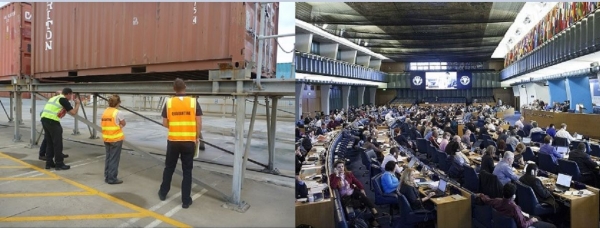
B3 science made a notable contribution to advance the development of an International Standard for Phytosanitary Measures (ISPM), to reduce the incidence of pests on sea containers, at a May 2016 meeting of the Commission on Phytosanitary Measures (CPM). The CPM is the governing body of the International Plant Protection Convention (IPPC) which is part of the Food and Agriculture Organisation of the United Nations. The IPPC establishes standards for international trade with an eye to preventing the spread of diseases and pests that damage agriculture and forestry.
B3 and Scion scientist Dr Ecki Brockerhoff presented a paper at this meeting in Rome to show the risks associated with sea containers moving pests and other contaminants around the world, and the potential benefits of developing an international phytosanitary standard for sea containers. Brockerhoff’s presentation was part of a broader consideration by the IPPC to examine a proposal for a binding ISPM to set stricter measures for sea containers. He was part of the New Zealand delegation led by Mr Peter Thomson of the Ministry for Primary Industries.
Around 90 percent of world trade is carried by sea today, and the cargo as well as the containers themselves can be vectors for the spread of exotic species.
Brockerhoff’s analysis of 116,701 empty sea containers arriving in New Zealand during the past five years showed that one in 10 was contaminated on the outside, twice the rate of interior contamination. Unwelcome pests included the gypsy moth, the Giant African snail, Argentine ants and the brown marmorated stink bug. Soil residues were the most common contaminant and contained the seeds of invasive plants, nematodes and plant pathogens.
“Inspection records from the United States, Australia, China and New Zealand indicate that thousands of organisms from a wide range of taxa are being moved unintentionally with sea containers,” said Brockerhoff.
Brockerhoff also presented a conceptual analysis of the benefits and costs of mitigation measures for sea container contamination, using New Zealand as an example. New Zealand, which is highly reliant on agricultural and horticultural exports, has implemented a highly sophisticated biosecurity and container hygiene system with several Pacific Island nations in order to keep invasive species out. It relies on partnership with the shipping industry and inspections at a host of Pacific ports and offers the incentive of fewer inspections upon arrival for those who comply.
Prior to the adoption of this sea container hygiene system, one in two empty containers arriving in New Zealand (from those origins) were contaminated; the system has reduced the contamination rate by 90%. This example suggests that a wider international sea container ISPM is likely to provide net financial benefits by reducing contamination rates and necessary inspections. Brockerhoff recommended that a thorough evaluation of the ISPM several years after implementation would allow the assessment of its relative benefits and costs.
While the CPM delegates made the final decision that additional time is needed to develop the details of the ISPM, they agreed that the risks are significant enough to warrant action and the intention is to develop an ISPM that will be global in reach.
Peter Thomson says, “While the risk from sea container contamination is obvious to New Zealand, many countries either don’t understand the risk, or believe it’s just too hard to manage. Having Dr Brockerhoff present his findings to the 182 members countries of the IPPC was instrumental in gaining sufficient support to continue the work to better manage this risk at an international level.”
B3 Director Dr David Teulon says, “It’s gratifying to see B3 research influencing biosecurity policy at the highest level and supporting MPI in the process.”
Contact: Dr Ecki Brockerhoff ([email protected])
See also: http://www.fao.org/news/story/en/item/412511/icode/
